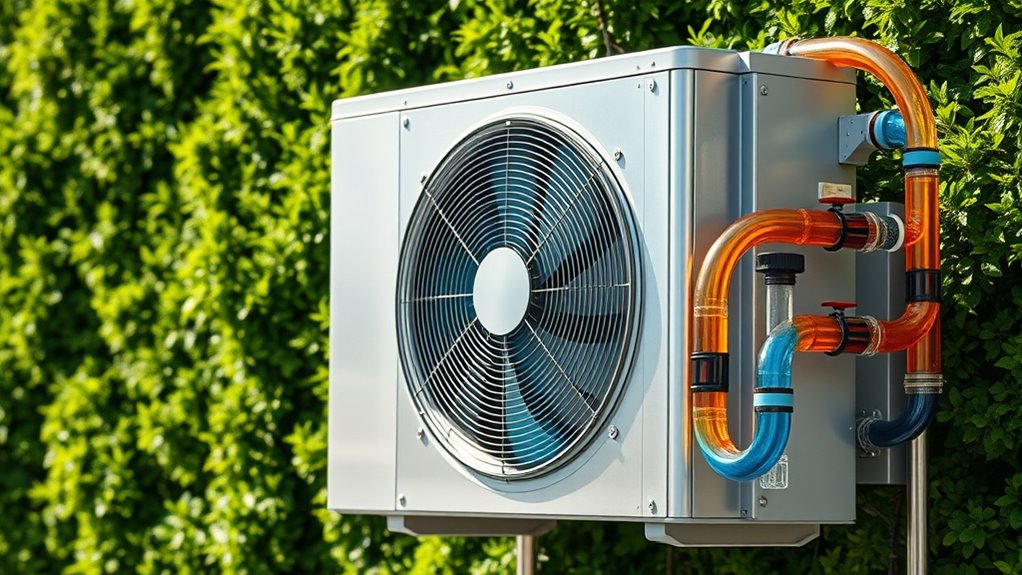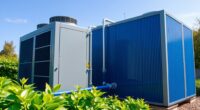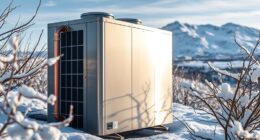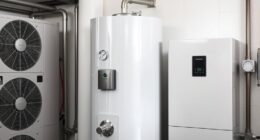Explore innovative thermal energy transfer strategies in heat pump designs, like high-temperature systems with variable-speed compressors, and hybrid setups combining solar and air sources. See how latent heat storage, phase change materials, and borehole thermal energy storage improve efficiency and sustainability in buildings, industrial processes, and passive homes. Smart controls and eco-friendly refrigerants optimize performance while supporting renewable integration. Keep exploring to discover how these advanced techniques can transform your energy solutions and sustainability efforts.
Key Takeaways
- Hybrid systems combining solar collectors, gas boilers, and heat pumps achieve high-temperature outputs for diverse applications.
- Borehole thermal energy storage enhances seasonal thermal management in ground-source heat pump systems.
- PCM-based thermal batteries and ice storage efficiently buffer peak loads and balance renewable energy supply.
- Reversible cycle heat pumps utilizing eco-friendly refrigerants enable simultaneous heating and cooling with high efficiency.
- Smart control systems integrate thermal storage and renewable sources to optimize performance and energy savings.
Advanced High-Temperature Heat Pump Systems for Industrial Applications
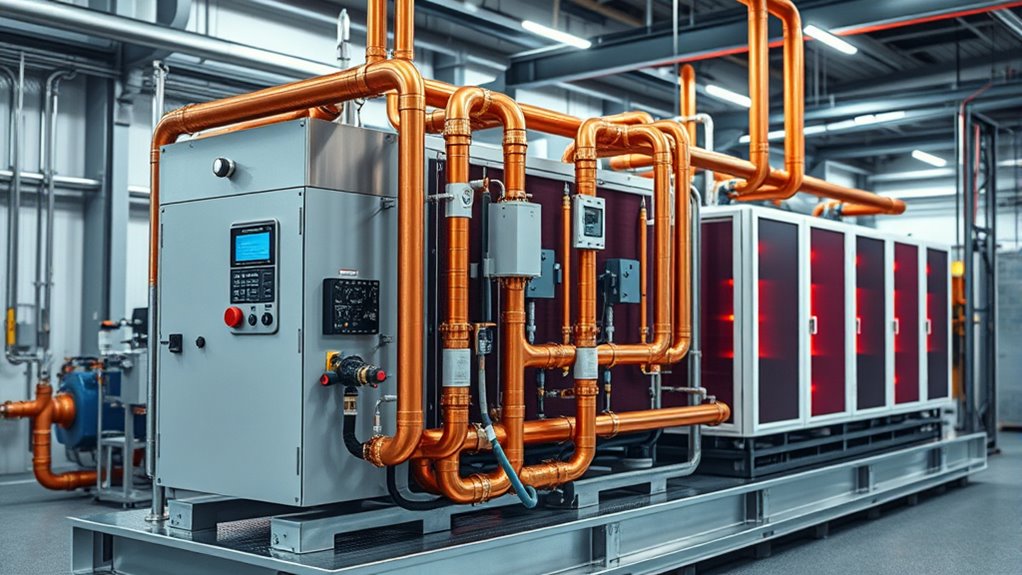
Advanced high-temperature heat pump systems are transforming industrial heating by delivering outlet temperatures up to 72 °C through the use of three variable speed piston compressors. These high-temperature heat pumps excel in industrial applications by maximizing thermal energy transfer efficiently. They utilize specially designed refrigerants, such as tetrafluoroethane, to enable effective heat transfer at high outlet temperatures. By leveraging renewable energy sources like geothermal or solar thermal, these systems achieve high efficiency and reduce reliance on fossil fuels. Hybrid configurations combine solar thermal collectors, gas boilers, and heat pumps, optimizing energy use for industrial heating needs. This integration facilitates sustainable, low-carbon solutions that seamlessly fit into existing infrastructure, enhancing performance and promoting energy savings in large-scale industrial processes. Additionally, advancements in system efficiency help lower operational costs and improve long-term sustainability outcomes. Incorporating advanced control systems further enhances performance by precisely adjusting operational parameters to match fluctuating energy demands and source availability. Moreover, innovations in thermal energy transfer improve the overall effectiveness of these systems, ensuring they meet the demanding needs of modern industry. Understanding personality traits can also contribute to more effective teamwork and leadership within industrial project management, fostering better collaboration and innovation. Implementing innovative heat exchange technologies can further optimize the energy transfer process, leading to even greater system efficiency.
Utilization of Latent Heat Storage in Multi-Use Building Heating Solutions
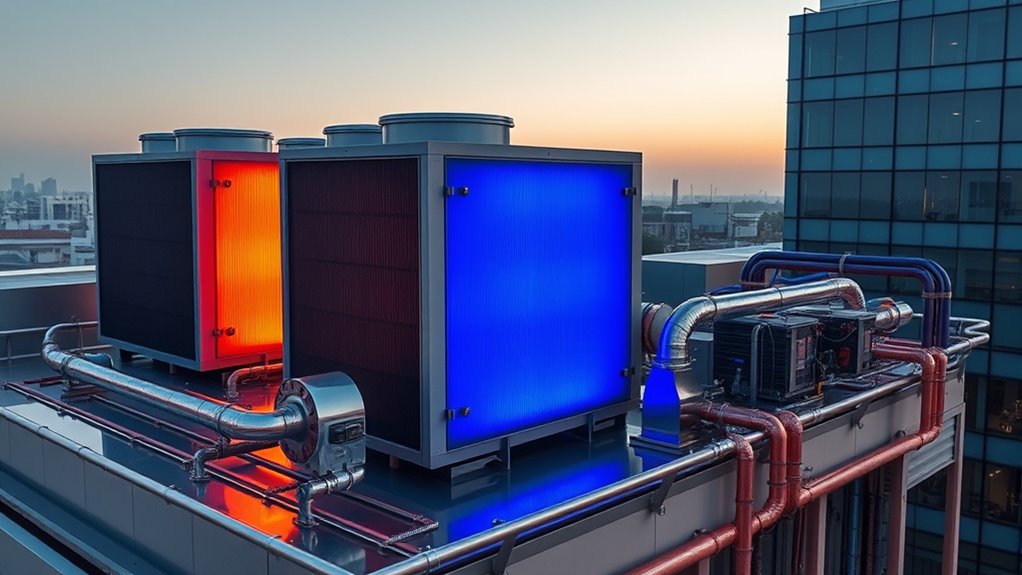
Latent heat storage expands your building’s thermal capacity by efficiently storing and releasing energy during phase changes. By optimizing heat exchange with phase change materials, your system can better balance loads and improve performance. Integrating PCM-based thermal batteries helps you reduce energy consumption and enhance indoor comfort across multiple uses. Additionally, understanding the Relationships – Personality Test can provide insights into designing systems that better meet occupant needs and foster a comfortable environment. Employing mixing techniques can further refine the overall impact of your trailer compositions, ensuring seamless integration of thermal components. Incorporating renewable energy sources in hydrogen production can further lower the environmental impact of your thermal systems.
Enhancing Thermal Storage Capacity
To enhance thermal storage capacity in multi-use building heating systems, integrating phase change materials (PCMs) that utilize latent heat storage offers a highly effective solution. Latent heat storage markedly boosts energy storage capacity by storing large amounts of thermal energy during melting and solidification cycles without increasing volume. Ice storage systems, a common PCM application, provide thermal buffering and improve thermal regulation during peak demand, especially when combined with heat pump integration. This approach optimizes thermal energy transfer, reduces reliance on fossil fuels, and enhances overall efficiency. In multi-use buildings, these systems enable better management of fluctuating energy needs, ensuring reliable heating and cooling while lowering operational costs and supporting sustainable energy strategies.
Optimizing Heat Exchange Efficiency
Utilizing phase change materials (PCMs) for heat storage markedly improves heat exchange efficiency in multi-use building heating systems. Latent heat storage enables thermal energy transfer during melting and solidification, smoothing temperature fluctuations. This results in enhanced heat pump efficiency and a higher coefficient of performance (COP). Ice storage, as seen in projects like Hot Ice Weiz, offers high-capacity thermal storage that optimizes heat exchange during peak and off-peak periods. To maximize benefits, consider:
- Integrating latent heat storage for consistent indoor temperatures
- Using ice storage to balance renewable energy supply and demand
- Reducing operational energy through heat exchange optimization
- Enhancing thermal storage systems for better renewable energy integration
- Improving overall thermal energy transfer efficiency in multi-use buildings
- Incorporating AI-driven analytics to predict and optimize thermal performance under varying conditions
- Embracing phase change technology to further enhance thermal energy management and system flexibility
- Leveraging thermal storage advancements to develop more efficient and adaptable heat exchange solutions
- Exploring smart control systems that dynamically regulate thermal storage for optimal performance
These strategies elevate thermal energy transfer and system sustainability.
Integrating Phase Change Materials
Integrating phase change materials (PCMs) into building heating systems offers a highly effective way to enhance energy storage and improve overall efficiency. PCMs enable thermal energy storage by absorbing and releasing latent heat during their melting and solidification processes. When embedded within building walls, floors, or dedicated storage units, they stabilize indoor temperatures, support thermal regulation, and reduce peak heating demands. This integration allows for load shifting, making better use of renewable energy sources and increasing energy efficiency. In heat pump systems, PCM-based thermal storage can absorb excess heat during off-peak hours and release it when needed, lowering energy consumption. Pilot projects show that incorporating PCMs can reduce energy use by up to 20%, making buildings more sustainable and resilient. The effectiveness of PCMs is also influenced by their color fidelity and stability over repeated thermal cycles, which are critical factors for long-term performance. Additionally, advances in thermal energy storage materials are expanding the potential applications of PCMs in various building types and climates. Incorporating advanced encapsulation techniques can further enhance the durability and performance of PCMs over time, ensuring sustained energy savings and system reliability. Furthermore, understanding the weight of wind turbine blades is crucial for designing efficient renewable energy systems that complement thermal energy solutions. Moreover, ongoing research into phase change material durability is essential to ensure the long-term viability of these systems under real-world conditions.
Integration of Borehole Thermal Energy Storage With Ground-Source Heat Pumps
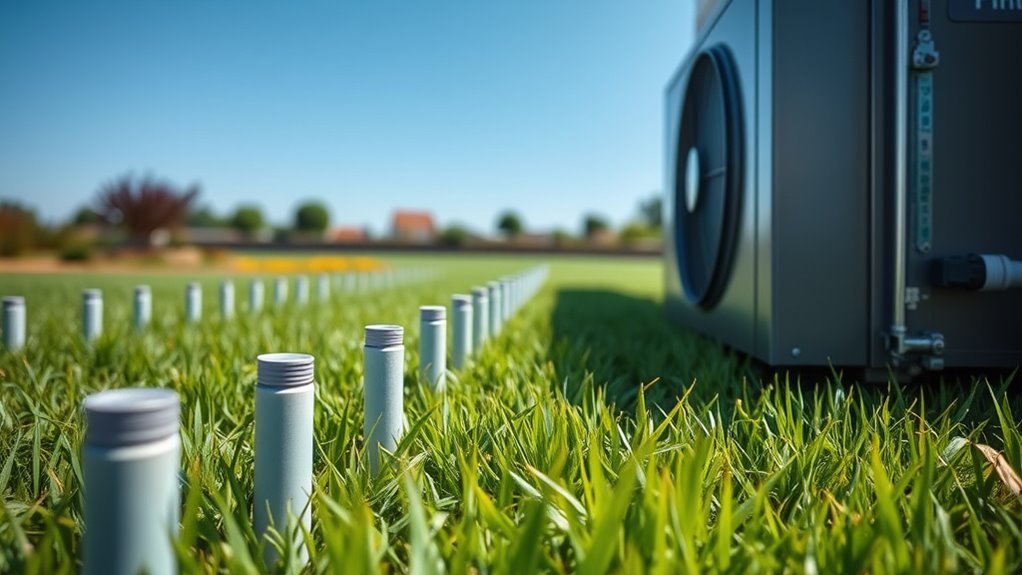
The combination of Borehole Thermal Energy Storage (BTES) systems with ground-source heat pumps offers a strategic way to enhance energy efficiency and sustainability. By leveraging borehole thermal energy storage, you can efficiently buffer seasonal thermal variations, providing a stable heat source or sink year-round. This thermal energy transfer enables the integration of renewable energy storage, reducing reliance on external power sources. With deep boreholes, excess heat—such as solar or waste heat—can be stored for later use, boosting system performance. High-temperature heat pumps benefit from this setup, delivering outputs up to 72 °C for large-scale applications. Additionally, utilizing eco-friendly practices in the installation and operation of these systems can further minimize environmental impacts and support sustainable energy goals. Incorporating thermal conductivity improvements in borehole design can significantly improve heat transfer efficiency, especially when combined with energy-efficient system components to maximize overall performance. Moreover, optimizing ground coupling techniques can enhance the thermal exchange process, leading to improved system longevity and efficiency.
Hybrid Heat Pump Technologies Combining Solar Thermal and Ambient Air Sources

Hybrid heat pump systems that combine solar thermal collectors with ambient air sources can boost efficiency and cut energy costs. By leveraging solar energy during peak sunlight, these systems reduce reliance on electricity and lower emissions. Understanding how these integrations maximize benefits will help you evaluate their potential in sustainable heating solutions. Additionally, advancements in refrigerant technology contribute to the overall environmental friendliness of these systems. Incorporating regulatory compliance considerations can further enhance adoption and performance. Moreover, integrating innovative heat transfer methods can optimize system performance and extend lifespan. Incorporating thermal energy transfer techniques from diverse applications may lead to improved heat pump efficiencies. As technology progresses, the integration of smart control systems can further refine operation and energy management.
Solar Thermal Integration Benefits
By combining solar thermal collectors with heat pump systems, you can substantially boost overall efficiency and reduce energy costs. Solar thermal integration allows your hybrid heating system to preheat the working fluid, decreasing electrical energy needs. This setup harnesses renewable thermal energy from solar collectors, lessening reliance on electrical or fossil fuels. During peak heating periods, solar collectors support system performance, ensuring consistent hot water and space heating. Benefits include:
- Increased heat pump efficiency through thermal energy transfer
- Significant energy savings and lower bills
- High-temperature outputs suitable for domestic hot water
- Reduced primary energy use and carbon emissions
- Enhanced system performance with renewable energy sources
- Incorporating sustainable materials in system components can further improve environmental benefits
Implementing solar thermal integration not only improves efficiency but also contributes to carbon reduction and sustainable living.
Ambient Air Source Efficiency
Combining solar thermal collectors with ambient air source heat pumps creates a highly efficient hybrid system that maximizes renewable energy use. By preheating the working fluid with solar thermal collectors, you reduce the energy load on the ambient air source component, boosting overall energy efficiency and system COP. Ambient air source heat pumps typically operate efficiently within a temperature range of -15°C to 10°C, but integrating solar thermal collectors helps sustain performance during colder months. This thermal transfer enhances climate adaptability, ensuring consistent operation. Whether configured as single or cascade systems, hybrid heat pumps capitalize on renewable energy, leading to significant energy savings—up to 30-50% compared to standalone air-source units. This synergy optimizes thermal transfer and improves overall system performance year-round.
Reversible Cycle Heat Pumps for Simultaneous Heating and Cooling in Residential Buildings
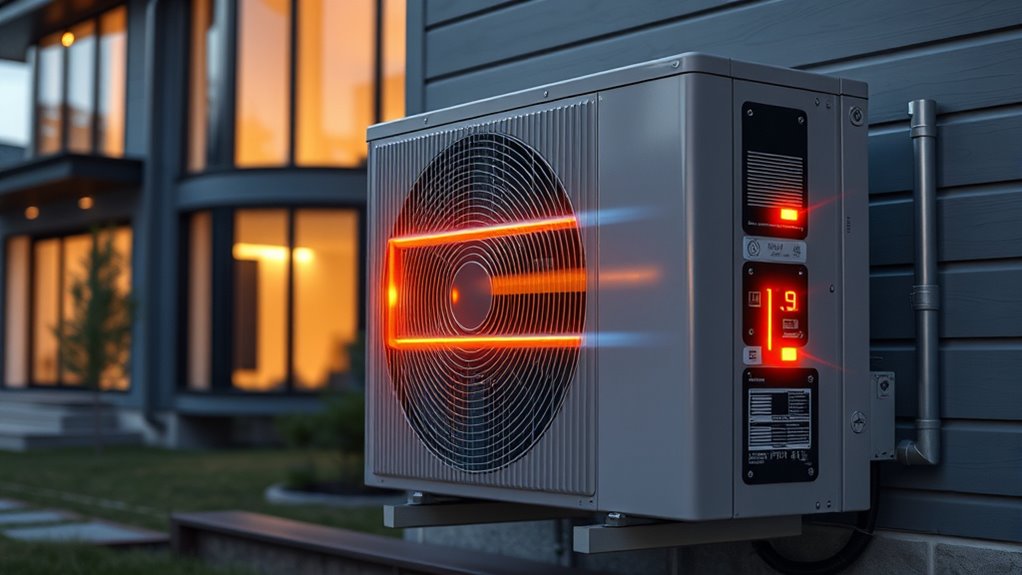
Reversible cycle heat pumps offer an efficient solution for maintaining comfort in residential buildings year-round by providing both heating and cooling from a single system. These heat pumps utilize a four-way valve to switch between modes, enabling simultaneous heating and cooling, which enhances thermal management. Their innovative design features adjustable refrigerant flow paths and control systems that optimize performance for each function. With high energy efficiency, COPs typically range between 3 and 5, reducing operational costs. This dual-mode system simplifies indoor climate control, ensuring consistent comfort regardless of season.
- Seamless shift between heating and cooling modes
- Enhanced thermal energy transfer for better efficiency
- Optimized heat pump cycle for dual functions
- Cost-effective operation for residential applications
- Improved thermal management in tight spaces
Innovative Working Fluids Enhancing Efficiency in Residential Heat Pump Systems
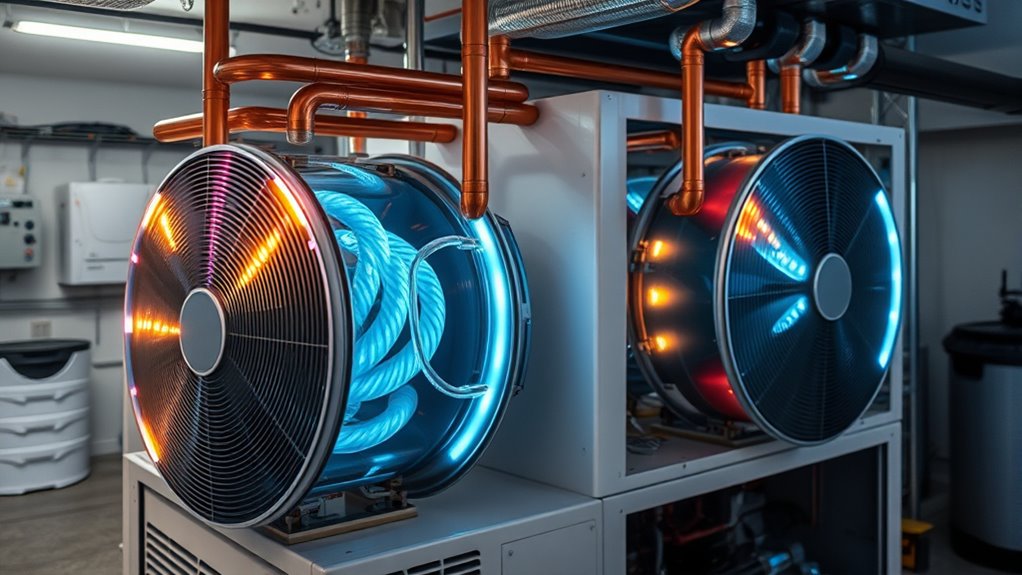
Innovative working fluids are transforming residential heat pump systems by boosting efficiency and environmental sustainability. By carefully selecting refrigerants with favorable thermodynamic properties, you can markedly improve thermal efficiency and energy performance. Modern refrigerants like tetrafluoroethane (R134a) and hydrofluoroolefins (HFOs, e.g., R1234yf) are environmentally friendly choices that reduce ozone depletion and GWP. Natural working fluids such as propane (R290) and ammonia (R717) offer excellent thermodynamic characteristics, enabling higher heat output at lower energy consumption, though they require careful handling. These advanced refrigerants operate efficiently across a broader temperature range, enhancing cold climate performance. Ultimately, refrigerant selection focused on low-GWP and sustainability supports the development of eco-friendly heat pumps that meet modern energy standards.
Smart Control Systems Optimizing Energy Transfer and Storage Efficiency
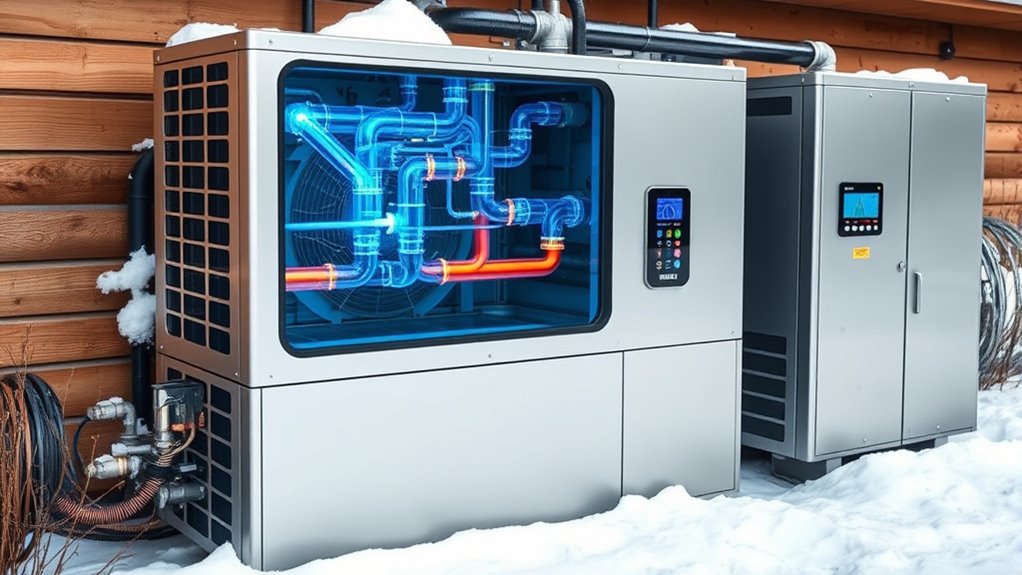
Smart control systems enhance heat pump efficiency by using real-time sensor data to optimize energy transfer and storage. By dynamically adjusting heating and cooling cycles, you improve system efficiency, occupant comfort, and energy management. IoT integration allows remote monitoring and fine-tuning, extending system lifespan. Predictive algorithms forecast thermal loads, enabling pre-heating or pre-cooling, which reduces energy consumption. These systems analyze data to identify maintenance needs early, preventing failures. Key benefits include:
- Precise thermal energy transfer adjustments
- Optimized energy storage utilization
- Improved system responsiveness through IoT
- Enhanced occupant comfort with adaptive controls
- Reduced operational costs via predictive analytics
Embracing smart control technology guarantees your heat pump operates at peak efficiency, conserving energy while maintaining comfort.
Case Study: Solar-Powered Heat Pumps in Passive and Zero-Energy Housing
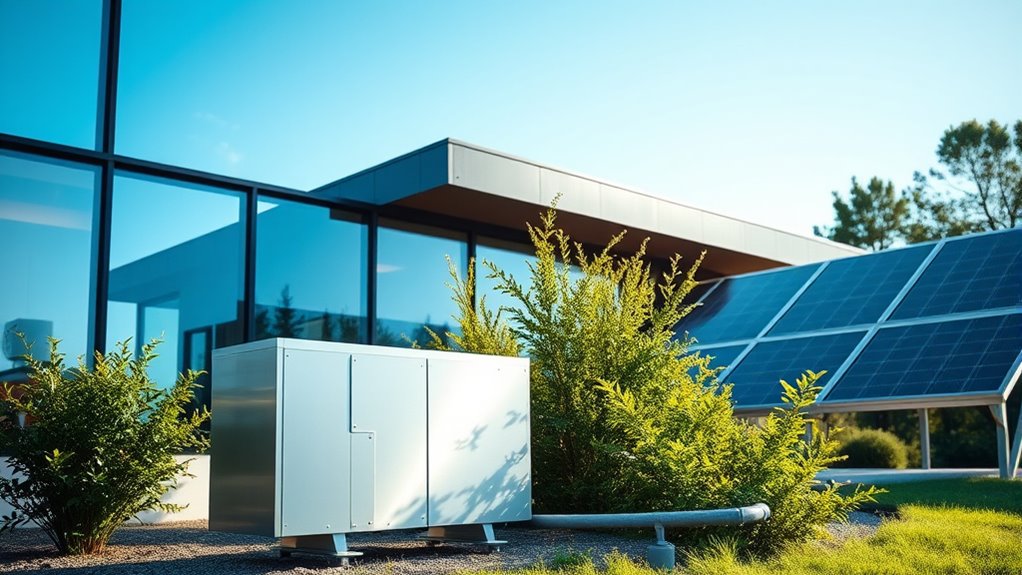
Have you ever considered how integrating solar energy with heat pump technology can transform passive and zero-energy homes? Solar thermal collectors work alongside heat pump systems to harness renewable energy, supporting hot water production and space heating. In passive housing and zero-energy buildings, this heat pump integration enhances overall energy efficiency, reducing reliance on grid electricity or fossil fuels. Solar-assisted systems, like those seen in Austria’s Vöglebichl Passive Houses and France’s projects, demonstrate how solar thermal collectors optimize thermal energy transfer, especially during sunny periods. These hybrid solutions lower operational costs and emissions, aligning with sustainable building goals. By combining solar thermal collectors with heat pumps, you create a system capable of meeting high standards such as net-zero energy, promoting a sustainable, energy-efficient future.
Adaptive Reuse of Historic Buildings Using Environmentally Friendly Heat Pump Technologies
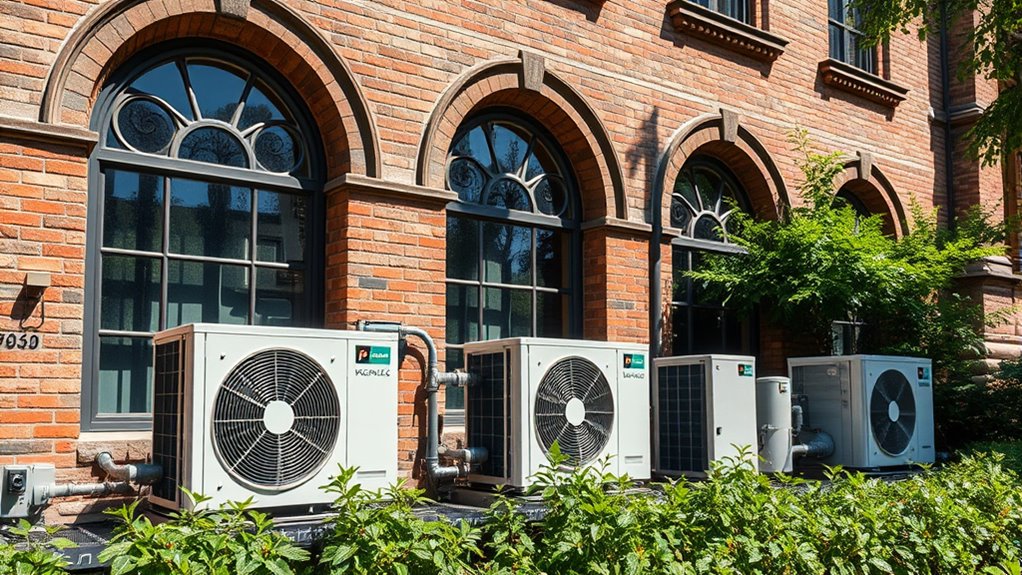
Integrating renewable heat pump technologies into historic building renovations offers a sustainable way to preserve architectural heritage while boosting energy efficiency. You can retrofit old structures with environmentally friendly heat pumps, harnessing renewable heat sources like ground or seawater. This approach not only reduces carbon emissions but also enhances thermal energy management in historic buildings.
Retrofitting historic buildings with renewable heat pumps enhances energy efficiency while preserving architectural heritage.
- Preserve architectural features through adaptive reuse
- Implement ground-source or seawater heat pumps for efficiency
- Reduce reliance on fossil fuels during renovation
- Lower carbon emissions with eco-friendly solutions
- Achieve sustainable renovation goals without sacrificing heritage
These projects demonstrate how innovative heat pump systems enable the adaptive reuse of historic buildings, balancing preservation with modern energy demands. This approach supports long-term sustainability and responsible renovation practices.
Frequently Asked Questions
How Do Innovative Heat Pump Designs Impact Overall Energy Efficiency?
You’ll find that innovative heat pump designs substantially boost overall energy efficiency. These advancements improve heat transfer, reduce energy consumption, and optimize performance in various conditions. By integrating new materials and technologies, you can achieve higher COP ratings and lower operating costs. As a result, your system becomes more sustainable, cost-effective, and better suited for renewable energy integration, making your energy use smarter and more environmentally friendly.
What Are the Environmental Benefits of Using Novel Working Fluids?
You’re about to discover how novel working fluids can revolutionize our environment! These cutting-edge fluids drastically reduce greenhouse gas emissions, making your heat pump way greener than traditional options. They also cut down on energy consumption, which means less pollution and a healthier planet. By choosing these innovative fluids, you’re not just saving energy—you’re actively fighting climate change, turning your everyday actions into powerful environmental heroism.
How Do Smart Control Systems Enhance Thermal Energy Transfer?
Smart control systems improve thermal energy transfer by precisely regulating heat pump operations in response to real-time data. You benefit from increased efficiency, reduced energy consumption, and optimized performance as these systems automatically adjust variables like temperature and flow rates. By adapting to changing conditions, they guarantee maximum heat transfer, lower costs, and a smaller environmental footprint, making your heating and cooling systems smarter and more sustainable.
Can Hybrid Systems Effectively Integrate Renewable Energy Sources?
You might think mixing renewable sources with hybrid systems is a tall order, but it’s a smart move. Hybrid systems can seamlessly integrate solar, wind, or geothermal energy, maximizing efficiency and reducing reliance on fossil fuels. They adapt to changing conditions, ensuring consistent performance. In this way, they prove that two heads are better than one, delivering reliable, sustainable heating and cooling while making the most of renewable resources.
What Challenges Exist in Scaling These Innovative Heat Pump Technologies?
You face several challenges when scaling innovative heat pump technologies. Cost remains a major barrier, as advanced systems often need high upfront investments. You also encounter technical issues like system compatibility and efficiency at larger scales. Additionally, regulatory hurdles and limited infrastructure can slow adoption. Overcoming these obstacles requires ongoing research, policy support, and increased awareness to make these sustainable solutions accessible and practical for widespread use.
Conclusion
By exploring innovative thermal energy transfer methods, you can substantially improve heat pump efficiency. For instance, imagine a community deploying a hybrid solar and ambient air heat pump system in a passive housing project, reducing energy bills and carbon footprint. Embracing these advancements allows you to optimize heating and cooling solutions, making your buildings more sustainable. So, whether retrofitting historic structures or designing new eco-friendly spaces, applying these innovations puts you at the forefront of energy-efficient technology.
